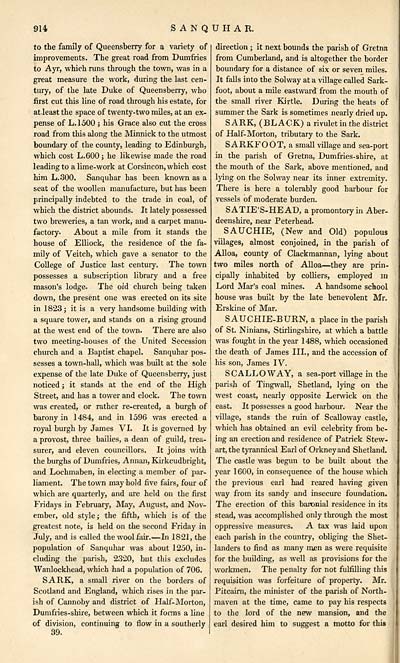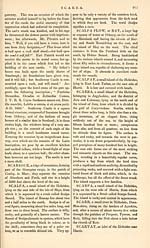Gazetteer of Scotland > Volume 2
(434) Page 914
Download files
Complete book:
Individual page:
Thumbnail gallery: Grid view | List view

914
SANQUHAR.
to the family of Queensberry for a variety of
improvements. The great road from Dumfries
to Ayr, which runs through the town, was in a
great measure the work, during the last cen-
tury, of the late Duke of Queensberry, who
first cut this line of road through his estate, for
atleast the space of twenty-two miles, at an ex-
pense of L.1500 ; his Grace also cut the cross
road from this along the Minnick to the utmost
boundary of the county, leading to Edinburgh,
which cost L.600 ; he likewise made the road
leading to a lime-work at Corsincon, which cost
him L.300. Sanquhar has been known as a
seat of the woollen manufacture, but has been
principally indebted to the trade in coal, of
which the district abounds. It lately possessed
two breweries, a tan work, and a carpet manu-
factory. About a mile from it stands the
house of Elliock, the residence of the fa-
mily of Veitch, which gave a senator to the
College of Justice last century. The town
possesses a subscription library and a free
mason's lodge. The old church being taken
down, the present one was erected on its site
in 1823; it is a very handsome building with
a square tower, and stands on a rising ground
at the west end of the town. There are also
two meeting-houses of the United Secession
church and a Baptist chapel. Sanquhar pos-
sesses a town-hall, which was built at the sole
expense of the late Duke of Queensberry, just
noticed ; it stands at the end of the High
Street, and has a tower and clock. The town
was created, or rather re-created, a burgh of
barony in 1484, and in 1596 was erected a
royal burgh by James VI. It is governed by
a provost, three bailies, a dean of guild, trea-
surer, and eleven councillors. It joins with
the burghs of Dumfries, Annan, Kirkcudbright,
and Lochmaben, in electing a member of par-
liament. The town may hold five fairs, four of
which are quarterly, and are held on the first
Fridays in February, May, August, and Nov-
ember, old style; the fifth, which is of the
greatest note, is held on the second Friday in
July, and is called the wool fair. — In 1821, the
population of Sanquhar was about 1250, in-
cluding the parish, 2320, but this excludes
Wanlockhead, which had a population of 706.
SARK, a small river on the borders of
Scotland and England, which rises in the par-
ish of Cannoby and district of Half- Morton,
Dumfries-shire, between which it forms a line
of division, continuing to flow in a southerly
39.
direction ; it next bounds the parish of Gretna
from Cumberland, and is altogether the border
boundary for a distance of six or seven miles.
It falls into the Solway at a village called Sark-
foot, about a mile eastward from the mouth of
the small river Kirtle. During the heats of
summer the Sark is sometimes nearly dried up.
SARK, (BLACK) a rivulet in the district
of Half- Morton, tributary to the Sark.
SARKFOOT, a small village and sea-port
in the parish of Gretna, Dumfries-shire, at
the mouth of the Sark, above mentioned, and
lying on the Solway near its inner extremity.
There is here a tolerably good harbour for
vessels of moderate burden.
SATIE'S-HEAD, a promontory in Aber-
deenshire, near Peterhead.
SAUCHIE, (New and Old) populous
villages, almost conjoined, in the parish of
Alloa, county of Clackmannan, lying about
two miles north of Alloa — they are prin-
cipally inhabited by colliers, employed in
Lord Mar's coal mines. A handsome school
house was built by the late benevolent Mr.
Erskine of Mar.
SAUCHIE-BURN, a place in the parish
of St. Ninians, Stirlingshire, at which a battle
was fought in the year 1488, which occasioned
the death of James III., and the accession of
his son, James IV.
SCALLOWAY, a sea-port village in the
parish of Tingwall, Shetland, lying on the
west coast, nearly opposite Lerwick on the
east. It possesses a good harbour. Near the
village, stands the ruin of Scalloway castle,
which has obtained an evil celebrity from be-
ing an erection and residence of Patrick Stew-
art, the tyrannical Earl of Orkney and Shetland.
The castle was begun to be built about the
year 1600, in consequence of the house which
the previous earl had reared having given
way from its sandy and insecure foundation.
The erection of this baronial residence in its
stead, was accomplished only through the most
oppressive measures. A tax was laid upon
each parish in the country, obliging the Shet-
landers to find as many men as were requisite
for the building, as well as provisions for the
workmen. The penalty for not fulfilling this
requisition was forfeiture of property. Mr.
Pitcairn, the minister of the parish of North-
maven at the time, came to pay his respects
to the lord of the new mansion, and the
earl desired him to suggest a motto for this
SANQUHAR.
to the family of Queensberry for a variety of
improvements. The great road from Dumfries
to Ayr, which runs through the town, was in a
great measure the work, during the last cen-
tury, of the late Duke of Queensberry, who
first cut this line of road through his estate, for
atleast the space of twenty-two miles, at an ex-
pense of L.1500 ; his Grace also cut the cross
road from this along the Minnick to the utmost
boundary of the county, leading to Edinburgh,
which cost L.600 ; he likewise made the road
leading to a lime-work at Corsincon, which cost
him L.300. Sanquhar has been known as a
seat of the woollen manufacture, but has been
principally indebted to the trade in coal, of
which the district abounds. It lately possessed
two breweries, a tan work, and a carpet manu-
factory. About a mile from it stands the
house of Elliock, the residence of the fa-
mily of Veitch, which gave a senator to the
College of Justice last century. The town
possesses a subscription library and a free
mason's lodge. The old church being taken
down, the present one was erected on its site
in 1823; it is a very handsome building with
a square tower, and stands on a rising ground
at the west end of the town. There are also
two meeting-houses of the United Secession
church and a Baptist chapel. Sanquhar pos-
sesses a town-hall, which was built at the sole
expense of the late Duke of Queensberry, just
noticed ; it stands at the end of the High
Street, and has a tower and clock. The town
was created, or rather re-created, a burgh of
barony in 1484, and in 1596 was erected a
royal burgh by James VI. It is governed by
a provost, three bailies, a dean of guild, trea-
surer, and eleven councillors. It joins with
the burghs of Dumfries, Annan, Kirkcudbright,
and Lochmaben, in electing a member of par-
liament. The town may hold five fairs, four of
which are quarterly, and are held on the first
Fridays in February, May, August, and Nov-
ember, old style; the fifth, which is of the
greatest note, is held on the second Friday in
July, and is called the wool fair. — In 1821, the
population of Sanquhar was about 1250, in-
cluding the parish, 2320, but this excludes
Wanlockhead, which had a population of 706.
SARK, a small river on the borders of
Scotland and England, which rises in the par-
ish of Cannoby and district of Half- Morton,
Dumfries-shire, between which it forms a line
of division, continuing to flow in a southerly
39.
direction ; it next bounds the parish of Gretna
from Cumberland, and is altogether the border
boundary for a distance of six or seven miles.
It falls into the Solway at a village called Sark-
foot, about a mile eastward from the mouth of
the small river Kirtle. During the heats of
summer the Sark is sometimes nearly dried up.
SARK, (BLACK) a rivulet in the district
of Half- Morton, tributary to the Sark.
SARKFOOT, a small village and sea-port
in the parish of Gretna, Dumfries-shire, at
the mouth of the Sark, above mentioned, and
lying on the Solway near its inner extremity.
There is here a tolerably good harbour for
vessels of moderate burden.
SATIE'S-HEAD, a promontory in Aber-
deenshire, near Peterhead.
SAUCHIE, (New and Old) populous
villages, almost conjoined, in the parish of
Alloa, county of Clackmannan, lying about
two miles north of Alloa — they are prin-
cipally inhabited by colliers, employed in
Lord Mar's coal mines. A handsome school
house was built by the late benevolent Mr.
Erskine of Mar.
SAUCHIE-BURN, a place in the parish
of St. Ninians, Stirlingshire, at which a battle
was fought in the year 1488, which occasioned
the death of James III., and the accession of
his son, James IV.
SCALLOWAY, a sea-port village in the
parish of Tingwall, Shetland, lying on the
west coast, nearly opposite Lerwick on the
east. It possesses a good harbour. Near the
village, stands the ruin of Scalloway castle,
which has obtained an evil celebrity from be-
ing an erection and residence of Patrick Stew-
art, the tyrannical Earl of Orkney and Shetland.
The castle was begun to be built about the
year 1600, in consequence of the house which
the previous earl had reared having given
way from its sandy and insecure foundation.
The erection of this baronial residence in its
stead, was accomplished only through the most
oppressive measures. A tax was laid upon
each parish in the country, obliging the Shet-
landers to find as many men as were requisite
for the building, as well as provisions for the
workmen. The penalty for not fulfilling this
requisition was forfeiture of property. Mr.
Pitcairn, the minister of the parish of North-
maven at the time, came to pay his respects
to the lord of the new mansion, and the
earl desired him to suggest a motto for this
Set display mode to: Large image | Transcription
Images and transcriptions on this page, including medium image downloads, may be used under the Creative Commons Attribution 4.0 International Licence unless otherwise stated. ![]()
| Gazetteers of Scotland, 1803-1901 > Gazetteer of Scotland > Volume 2 > (434) Page 914 |
|---|
| Permanent URL | https://digital.nls.uk/97436030 |
|---|
| Description | Volume II: Glenbanchor to Zetland. |
|---|---|
| Attribution and copyright: |
|
| Description | By Robert Chambers and William Chambers. Glasgow: Blackie & Son, 1838. 2 volumes. |
|---|---|
| Shelfmark | NF.1461.g.7 |
| Additional NLS resources: | |

